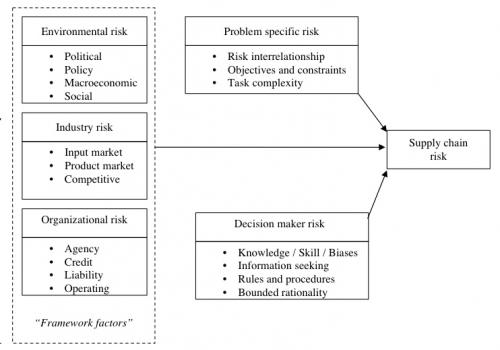Topology of Supply Chain Risks
S. Rao and T.J. Goldsby’s published an article in 2009 on the topic of “Supply chain risks: a review and typology”.
The article is devided into three sections. Definition of Risk / supply chain risk, overview of supply chain risk literature and identifying risks in the supply chain.Rao and Goldsby first summarize some of the definitions for risk. After a short introduction of the origin of risk in the research they start with the question if you should look at risk either as only the adverse effects of a possible event or as negative and positive consequences (so not only the risk but also the opportunities).
Managers tend to interpret risk as only the downside part so the authors decide to concentrate on this as well. To support their point they summarize eight definitions for risk starting in the 1950s with the definition by Markowitz, two of those define “risk” as risk and opportunity.
Building on this Rao and Goldsby go on summarizing current definitions of supply chain risk management, starting with Christopher (2002) to Manuj and Mentzer (2008). Concluding that “any approach to SCRM needs to look at understanding and reducing vulnerability to the supply chain as a whole, rather than at a focal firm level. In other words, the quest is for a global optimum rather than a local one.”
In the next part the authors summarize the key contributions of 55 selected papers on SCRM in one sentence.
In part three they develop a framework to identify risks in the supply chain.
Each risk (beside “problem specific risk” and “decision maker risk”) is discussed and explained in detail.
Conclusion
The paper appears as three very distinct parts. The parts are only loosely connected and each one could have made separate papers as well.
Part One: The risk definition is to short and very one sided to be used for a discussion of what risk or supply chain risk management really is or should be. For example, there is no differentiation between risk and uncertainty and the terms are used for each other without consideration. Furthermore the argument for only taking the downside of risk into account, neglecting opportunities, is discussed, but result is not satisfying, since in many cases optimal decisions can only be meet when both sides are taken into account.
Part Two: Overall Rao and Goldsby deliver a good and broad review of the SCRM literature, even though it is only indicative and not exhaustive as they note.
Part Three: Here the authors try to define a new risk framework for managing supply chain risks. After reading the definitions for supply chain risk management (Quote: “…collaborative risk management…”) I was expecting nothing less than a framework which includes risks not only of the individual supply chain actors, but also the supply chain as a whole. But it seems that the presented framework is a collection of several already known risk sources for a single company, the two new aspects in their framework (“problem specific risk” and “decision maker risk”) are not discussed and left for further research.
Rao, S., & Goldsby, T. (2009). Supply chain risks: a review and typology The International Journal of Logistics Management, 20 (1), 97-123 DOI: 10.1108/09574090910954864









Add new comment